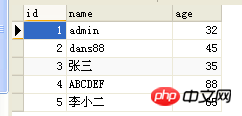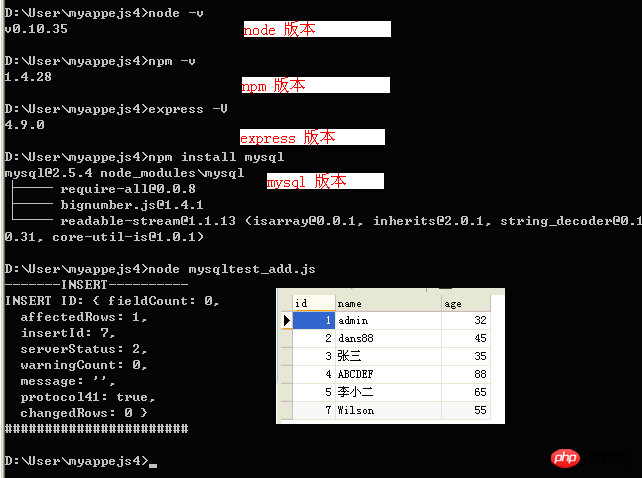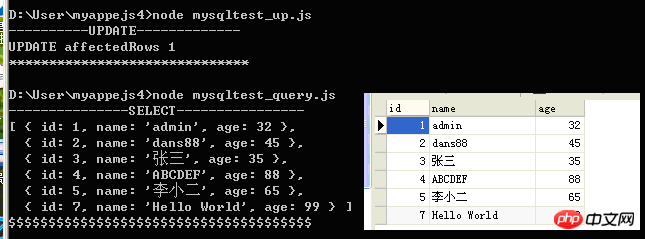
This article mainly introduces the method of Nodejs connecting to mysql and realizing the operations of adding, deleting, modifying and querying. It combines the example form with a detailed analysis of the connection of nodejs to mysql database, the creation of mysql database and the nodejs adding, deleting, modifying and querying of mysql. For specific implementation skills of related operations, friends in need can refer to
This article describes how Nodejs connects to mysql and implements add, delete, modify, and check operations. Share it with everyone for your reference, the details are as follows:
1. Prepare
nodejs tutorials, most of which use mongodb as an example. However, mongodb has some limitations, which are stated on the official website. I plan to use MySQL because I still have some experience using it. Focus on research first. node-mysql is currently the most popular mysql driver under node. I used it initially, because the asynchronous callback method really has a lot of pitfalls.
The package name of the following project is mysql, and the version is mysql@ 2.5.4
First explain the code shown below, which all starts with the following code, and will not be explained later
var connection = mysql.createConnection({
host : '127.0.0.1',
user : 'root',
password : 'root123',
port: '3306',
database: 'my_news_test',
});The meaning of the code is very straightforward. If you want to go deeper, you can go to the official website above to check. Configurations such as host and user should be clear to those who have written MySQL database applications. Please modify the corresponding parameters by yourself. The following code assumes that there is a table called node_use in the database "my_news_test". The table has 3 attributes
id: auto-increment primary key
name: The name has unique restrictions.
age: Age
Test MySQL MySQL version: 5.5
2. Create a database and insert 5 entries Record
Source Database : my_news_test SET FOREIGN_KEY_CHECKS=0; -- ---------------------------- -- Table structure for node_user -- ---------------------------- DROP TABLE IF EXISTS `node_user`; CREATE TABLE `node_user` ( `id` int(11) NOT NULL AUTO_INCREMENT, `name` varchar(30) DEFAULT NULL, `age` int(8) DEFAULT NULL, PRIMARY KEY (`id`) ) ENGINE=InnoDB AUTO_INCREMENT=6 DEFAULT CHARSET=utf8; -- ---------------------------- -- Records of node_user -- ---------------------------- INSERT INTO `node_user` VALUES ('1', 'admin', '32'); INSERT INTO `node_user` VALUES ('2', 'dans88', '45'); INSERT INTO `node_user` VALUES ('3', '张三', '35'); INSERT INTO `node_user` VALUES ('4', 'ABCDEF', '88'); INSERT INTO `node_user` VALUES ('5', '李小二', '65');
3. Test the environment first
1. First you need to install the mysql package of nodejs
D:\User\myappejs4>npm install mysql mysql@2.5.4 node_modules\mysql ├── require-all@0.0.8 ├── bignumber.js@1.4.1 └── readable-stream@1.1.13 (inherits@2.0.1, string_decoder@0.10.31, isarray@0 .0.1, core-util-is@1.0.1)
2. Write code for interaction between nodejs and mysql
//mysql.js
//首先需要安装nodejs 的mysql包
//npm install mysql
//编写nodejs与mysql交互的代码
var mysql = require('mysql');
var TEST_DATABASE = 'my_news_test';
var TEST_TABLE = 'node_user';
//创建连接
var client = mysql.createConnection({
user: 'root',
password: 'root123',
});
client.connect();
client.query("use " + TEST_DATABASE);
client.query(
'SELECT * FROM '+TEST_TABLE,
function selectCb(err, results, fields) {
if (err) {
throw err;
}
if(results)
{
for(var i = 0; i < results.length; i++)
{
console.log("%d\t%s\t%s", results[i].id, results[i].name, results[i].age);
}
}
client.end();
}
);3. Running results
D:\User\myappejs4>node mysqltest.js 1 admin 32 2 dans88 45 3 张三 35 4 ABCDEF 88 5 李小二 65

4. Node. js combined with MySQL's add, delete, modify, and query operations
1, add
var mysql = require('mysql');
var connection = mysql.createConnection({
host : '127.0.0.1',
user : 'root',
password : 'root123',
port: '3306',
database: 'my_news_test',
});
connection.connect();
var userAddSql = 'INSERT INTO node_user(id,name,age) VALUES(0,?,?)';
var userAddSql_Params = ['Wilson', 55];
//增 add
connection.query(userAddSql,userAddSql_Params,function (err, result) {
if(err){
console.log('[INSERT ERROR] - ',err.message);
return;
}
console.log('-------INSERT----------');
//console.log('INSERT ID:',result.insertId);
console.log('INSERT ID:',result);
console.log('#######################');
});
connection.end();run as follows
D:\User\myappejs4>node mysqltestadd.js
-------INSERT----------
INSERT ID: { fieldCount: 0,
affectedRows: 1,
insertId: 6,
serverStatus: 2,
warningCount: 0,
message: '',
protocol41: true,
changedRows: 0 }
#######################
2. Change
var mysql = require('mysql');
var connection = mysql.createConnection({
host : '127.0.0.1',
user : 'root',
password : 'root123',
port: '3306',
database: 'my_news_test',
});
connection.connect();
var userModSql = 'UPDATE node_user SET name = ?,age = ? WHERE id = ?';
var userModSql_Params = ['Hello World',99,7];
//改 up
connection.query(userModSql,userModSql_Params,function (err, result) {
if(err){
console.log('[UPDATE ERROR] - ',err.message);
return;
}
console.log('----------UPDATE-------------');
console.log('UPDATE affectedRows',result.affectedRows);
console.log('******************************');
});
connection.end();and the running result is as follows
D:\User\myappejs4>node mysqltest_up.js ----------UPDATE------------- UPDATE affectedRows 1 ******************************
3. Check the operation
var mysql = require('mysql');
var connection = mysql.createConnection({
host : '127.0.0.1',
user : 'root',
password : 'root123',
port: '3306',
database: 'my_news_test',
});
connection.connect();
var userGetSql = 'SELECT * FROM node_user';
//查 query
connection.query(userGetSql,function (err, result) {
if(err){
console.log('[SELECT ERROR] - ',err.message);
return;
}
console.log('---------------SELECT----------------');
console.log(result);
console.log('$$$$$$$$$$$$$$$$$$$$$$$$$$$$$$$$$$$$$$');
});
connection.end();and the running result is as follows
D:\User\myappejs4>node mysqltest_query.js
---------------SELECT----------------
[ { id: 1, name: 'admin', age: 32 },
{ id: 2, name: 'dans88', age: 45 },
{ id: 3, name: '张三', age: 35 },
{ id: 4, name: 'ABCDEF', age: 88 },
{ id: 5, name: '李小二', age: 65 },
{ id: 6, name: 'Wilson', age: 55 } ]
$$$$$$$$$$$$$$$$$$$$$$$$$$$$$$$$$$$$$$
4. Delete operation
var mysql = require('mysql');
var connection = mysql.createConnection({
host : '127.0.0.1',
user : 'root',
password : 'root123',
port: '3306',
database: 'my_news_test',
});
connection.connect();
var userDelSql = 'DELETE FROM node_user WHERE id = 7';
//ɾ
connection.query(userDelSql,function (err, result) {
if(err){
console.log('[DELETE ERROR] - ',err.message);
return;
}
console.log('-------------DELETE--------------');
console.log('DELETE affectedRows',result.affectedRows);
console.log('&&&&&&&&&&&&&&&&&');
});
connection.end();
运行的结果如下
D:\User\myappejs4>node mysqltest_del.js
-------------DELETE--------------
DELETE affectedRows 1
&&&&&&&&&&&&&&&&&&&&&&&&&&&&&&&&&&
The above is what I compiled for everyone. I hope it will be helpful to everyone in the future.
Related articles:
How to package static resources in vue
What are the usages of async&await in Koa2?
In the zTree tree plug-in, how to implement click-loading in five-level regions across the country
How to implement node express personalized chat rooms?
The above is the detailed content of Use Nodejs to connect to mysql to implement basic operations. For more information, please follow other related articles on the PHP Chinese website!




